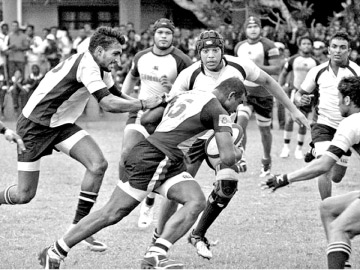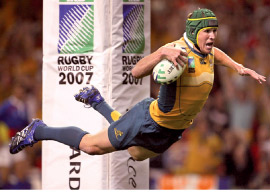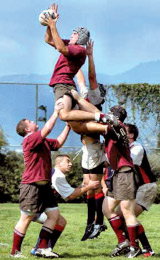The robust game of RUGBY
by Kamalanath Liyanage
  As we all know, rugby football
is a game of the strongest of sportsmen. Are you in a position to
realize that many things can happen until we make the try until the
kick-off? It is enriched with numerous ploys such as hits, tackles,
rucks, molls, scrums, line-outs, ball passing, kicks, and penalties with
the added enthusiasm of watching these phenomenons. In fact, rugby is an
intellectual game with vast applied disciplines. As we all know, rugby football
is a game of the strongest of sportsmen. Are you in a position to
realize that many things can happen until we make the try until the
kick-off? It is enriched with numerous ploys such as hits, tackles,
rucks, molls, scrums, line-outs, ball passing, kicks, and penalties with
the added enthusiasm of watching these phenomenons. In fact, rugby is an
intellectual game with vast applied disciplines.
Invention of the Rugby Football
Contemporary documents reveal that the history of the rugby football
game extends up to Greek times as they used to play a parallel game
called ‘episkyros’ and there even was a similar game known as “criapan”.
William Webb Elliswas was the person who introduced modern rugby to the
sports field in 1823. Moreover, the modern ploys and rules of the game
emerge from the game of football.
History of the Rugby ball
Data sources emphasize that, the founders of the rugby ball were
Willium Gilbert and Richard Lindon. Initially, balls were hand crafted
out of a leather casing surrounding a pig’s bladder and were blown up by
mouth or by hand using a piece of clay pipe. But this technique was
obsolete due to its unpleasant smell; the pig bladder could be diseased
and thus expose the blower to serious pathogens; the shape of the ball
differed from each other and the shape of a ball critically changed with
its usage. Eventually Richard Lindon replaced pig bladders.
Qualities of the Rugby ball
  Under Law 2 of the International Rugby Board (IRB), they established
the rugby ball in an oval shape made up of four panels which has a
length in-line of 280–300 millimeters, a circumference (end to end) of
740–770 millimeters, and a circumference (in width) of 580–620
millimeters. Water resistance and an easy-to-grip leather or suitable
synthetic material was permitted for making the balls. The weight of the
ball should be within the range of 410 grams and 460 grams. The
recommended air pressure of the ball is 65.71–68.75 kilopascals. The IRB
also states that smaller sizes may be used in games between younger
players. Under Law 2 of the International Rugby Board (IRB), they established
the rugby ball in an oval shape made up of four panels which has a
length in-line of 280–300 millimeters, a circumference (end to end) of
740–770 millimeters, and a circumference (in width) of 580–620
millimeters. Water resistance and an easy-to-grip leather or suitable
synthetic material was permitted for making the balls. The weight of the
ball should be within the range of 410 grams and 460 grams. The
recommended air pressure of the ball is 65.71–68.75 kilopascals. The IRB
also states that smaller sizes may be used in games between younger
players.
International recognition for rugby
The Rugby Union (the most popular form of rugby globally) is the
national sport in New Zealand, South Africa, Wales, Fiji, Samoa, Tonga
and Madagascar and this Rugby Union is administered by the IRB, whose
headquarters are located in Dublin, Ireland. It is even popular in Sri
Lanka where they compete in the international arena to local school
level.
Three main types of rugby can be observed vastly such as seven-a-side
rugby (rugby sevens), ten-a-side rugby and fifteen-a-side rugby. The
fifteen-a-side version of Rugby Union was last played at the Olympic
Games in Paris 1924 in which the United States team become gold
medalists. Rugby sevens will be admitted into the program of the Olympic
Games from Rio de Janeiro in 2016 onwards. |

